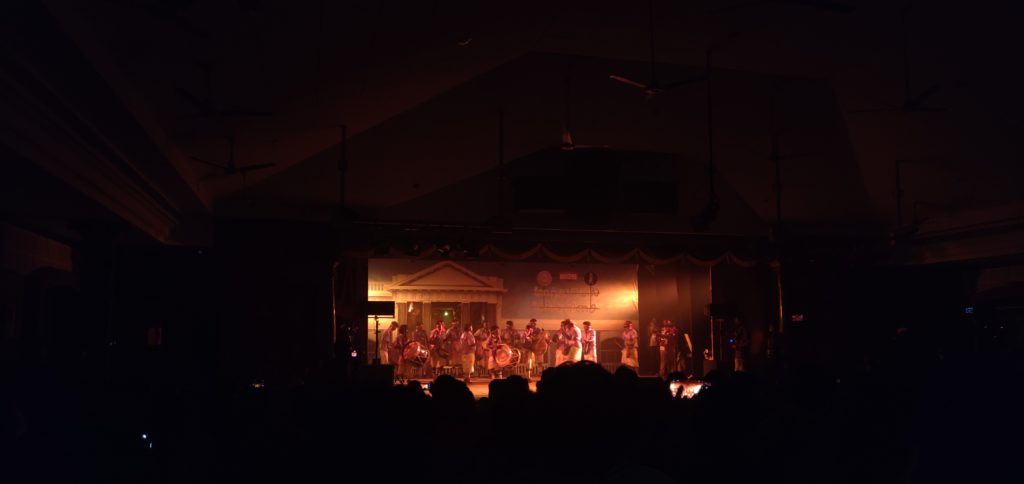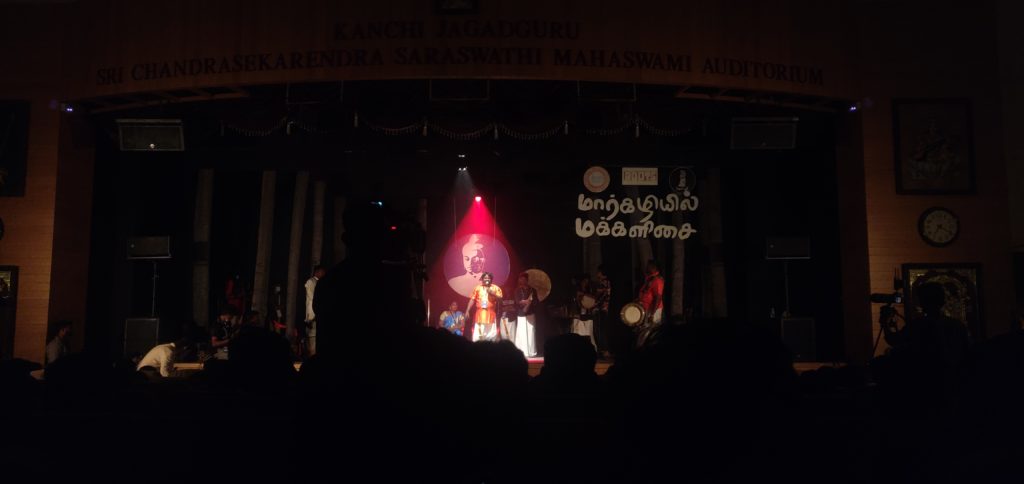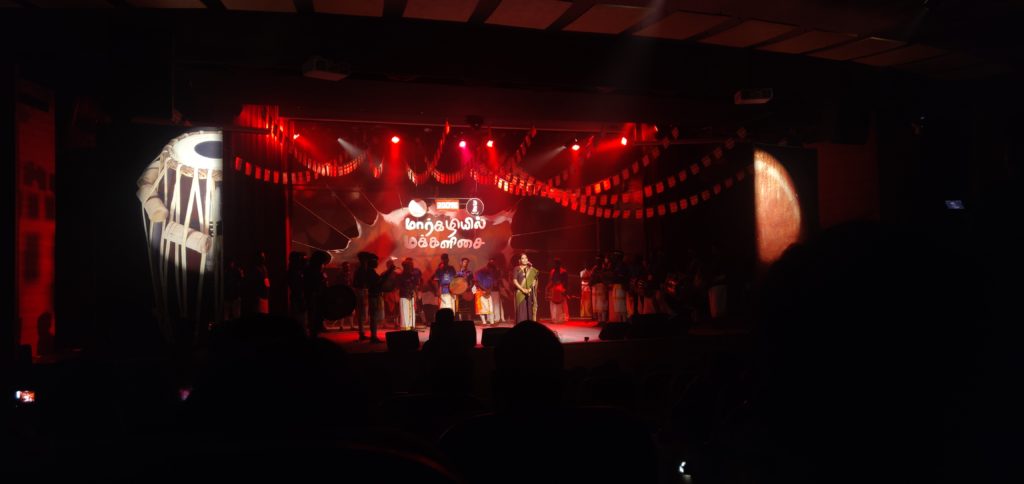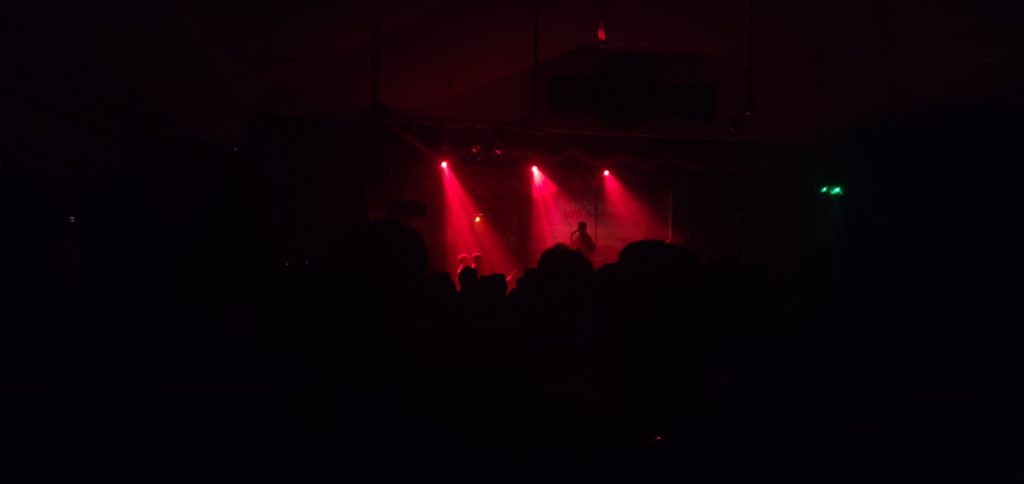Sonic Subversions: People’s Music at Chennai’s Margazhi Festival
AUTHOR
Krishna P Unny
The rhythmic jan jan jan of the Parai drums resound through a sabha hall, one of the many elite and conservative performance venues in the heart of Chennai. The artists dance with unmatched energy, moving from corner to corner onstage, in sync. In doing so, they claim the performance space, one that is seldom open to the marginalised. Most of them belong to the northern part of segregated Chennai, home to several Dalit performing communities, including those of Parai and Gaana artists [i]. Through their forceful drumming, they mark their presence sonically in the rest of the city—the posh, upper-caste neighbourhoods in central and south Chennai where it’s often the tha dhi thom nam-s of the classical Mridangam that dominate the rhythmic soundscape.

For almost a century, between December and January every year, the privately owned sabhas in this part of Chennai have hosted over 3000 music and dance performances as a part of the city’s ‘Music Season’. Falling in the Tamil month of Margazhi, this annual festival celebrating Chennai’s rich musical heritage has even given the city a place in UNESCO’s global Creative Cities Network. Yet, these festival spaces remain exclusionary. Organised by and for upper-caste, upper-class (often NRI) crowds, Carnatic music and Bharatanatyam concerts make for most of the Margazhi events [ii]. Subaltern performance practices are relegated to the margins, much like the communities of their practitioners.
In 2020 and 2021, the Margazhiyil Makkal Isai—People’s Music at the Margazhi—was organised by the Neelam Cultural Centre, an Ambedkarite arts organisation founded by eminent filmmaker and anti-caste activist Pa. Ranjith. The festival hosted previously excluded artforms and artists in Chennai’s prominent sabhas. The Parai performance marked the inauguration of the Margazhiyil Makkal Isai (henceforth MMI). This was followed by a presentation of Tamil ‘folk’ musical forms such as Oppari, Gaana, Nattupura padal and a ‘tribal music show’, among others. Diverse themes sprang from the songs performed—while some celebrated nature, language, love, unity, and resistance, others delved deep into loss, grief, struggle, and the mundanities of life. In the predominantly Brahminical venues which associate themselves with the ‘classical’ and therefore spiritual, these everyday songs and sounds of the people take on a new meaning. They give voice to Dalit agency [iii]. The music festival then becomes a site of sonic subversion. In this essay, I go a step further and argue that the disruptive element here is not simply the assertion of identity through sound, but the fact that the MMI used the very ability of sound to coalesce a community to create a larger Dalit solidarity.

Sonic Solidarities
In his 1972 novel Mumbo Jumbo, a satirical work of fiction set in 1920s America, Ishmael Reed talks about an epidemic caused by the “Jes Grew virus”. Unlike other viruses, Jes Grew did not cause physical illness. Instead, the infectious virus forced its hosts to listen to music, sing, and dance, leaving them more energised and ecstatic than before. For Reed, the virus symbolised Jazz and other Afro-American musical forms. It also represented the African diasporic cultural ethos of freedom and self-expression [iv]. The orthodox white American characters in the story found the virus ‘threatening’ lest it wreak havoc and start a pandemic. Spreading like wildfire, it brought many under its powerful influence.
Commenting on Jes Grew, Alex de Jung and Marc Schuilenberg contend that popular music creates an environment that makes it difficult for its listeners to remain neutral or distant. It pulls them in. The “sound virus”, as they argue, infects individuals, moves them, and brings them together in “sound communities” [v]. Sound communities have been defined as “clusters of social relations which emerge through a collective commitment to specific categories of sounds”. They come together “to interrupt or otherwise subvert dominant sound patterns” [vi]. Jes Grew too helped create a community of listeners of African-American music in a society dominated by white Americans.
In 2020 and 2021, the MMI was organised in Chennai—with necessary restrictions—while the city was tackling a global pandemic caused by the coronavirus. Unlike Jes Grew, the virus was real. Though highly uncharacteristic of Chennai in December, the city was silent. Most sabhas switched to virtual festivals and there was a significant lull in the sabha economy—that is perhaps what allowed the idea of the MMI to take shape. Despite the hurdles, the festival hosted over 500 artists from across Tamil Nadu and the performances were attended by a large and diverse audience. While it can be unnerving to read Reed’s virus alongside its real and disastrous counterpart, the idea of ‘sound communities’ is important for us to understand the implications of the MMI. Like Jes Grew, the festival too attempted to forge its own sound community. And this was achieved, I argue, by articulating or suturing the many Dalit sonicscapes within and outside the city [vii]

In Chennai and elsewhere, if you lend your ears to the soundscape, you notice that each nook has its own musical sounds and rhythms that it cherishes. For instance, different parts of Tamil Nadu have their own unique Parai taalams or rhythmic patterns [viii]. These regional differences create distinct soundscapes. It also creates a sense of regional identity among its artists and listeners. We see this in the case of Gaana and its relationship with north Chennai. While many mainstream Tamil movies often represent the area as a violent urban ghetto [ix], the lyrics of many Gaana songs attempt to undo this notion. They speak of the cultural moorings of the singers to these neighbourhoods and redefine them as spaces marked by love, kinship and a common struggle against oppressive systems—an example being Casteless Collective’s ‘Vada Chennai.’ This is much like Hip Hop, which as Johansson and Bell note, ‘constructs places […] such as the ghetto […] where these spaces, as symbols, provide the African American community with an identity […] now central to the form’s authenticity’ [x]. These individual, regional, and ‘authentic’ Dalit sonicscapes came together in the festival space of the MMI.

The Infection
Many young Tamil Rap artists, senior Gaana artists in Chennai, and performers from indigenous communities such as the Irulars and Kurumbars from elsewhere in the state, shared the same stage at the MMI. They performed together. The listeners of the music, coming from diverse socio-cultural backgrounds, were also active participants in the performance. They sang, danced, and cheered for and with the performers. The artists and audience exchanged intermittent ‘Jai Bhims’ and responded to common symbols and sounds of anti-caste resistance and solidarity—the Parai, songs on Buddha and Ambedkar, speeches on shared Tamil roots. Through these, they allowed themselves to move and be moved. In other words, Reed’s sound virus was at play. When the Parai drummers danced, beating the drums and asserting their voice, they too were acting as carriers, transmitting sounds and sharing sound experiences, and through these sonic interactions, forging a community.
MMI 2021, Krishna Gana Sabha, Chennai, Day 5 (Author’s Collection)
NOTES
[i] The Parai is an indigenous drum played by the Paraiyar community at weddings, temples, and funerals. Oppari refers to songs of lament or ritualised mourning. Gaana has its roots in north Chennai where it was performed as funerary music. Due to the associations of these forms with death, the forms and the communities of artists associated with them have been stigmatised. In the work cited below, Diwakar writes about the close links between Gaana and the northern, neglected part of the city.
Diwakar, Pranathi. “The Other City: Gaana Music Challenges the Singular, Homogenising Narratives of Chennai City.” Economic and Political Weekly. vol lV no. 4, 2020.
[ii] T.M. Krishna, Davesh Soneji, Nrithya Pillai among others have written about the caste and class exclusivity in Chennai’s classical music and dance scene. Charulata Mani’s recent work also delves into this. See,Mani, Charulata. “Chennai at the Cusp of Cultural Change”. Ballico, Christina, and Allan Watson, editors. Music Cities: Evaluating a Global Cultural Policy Concept. Springer, 2020.
[iii] Weidman, Amanda. “Gender and the Politics of Voice: Colonial Modernity and Classical Music in South India.” Cultural Anthropology, vol. 18, no. 2, 2003
Here, Weidman writes about the upper-caste women as Carnatic music performers in the early 20th century south India and highlights the link between the singing voice and agency.
[iv] Hawkins, Alfonso W. “Madam Zajj and Jes Grew: Ishmael Reed’s Codified Jazz Texts.” Obsidian III, vol. 5, no. 1, 2004.
[v] De Jong. A, Marc Schuilenberg. Mediapolis: Popular Culture and the City, 2006
[vi] Straw, Will. “Rhythmanalysis and Circulation” The Bloomsbury Handbook of Popular Music, Space and Place. Bloomsbury Academic, 2022.
[vii] I borrow the term from Davesh Soneji but use it loosely to refer to the regional soundscapes of Dalit neighbourhoods, many of which perform/meet at the festival space.
[viii] In an interview for The News Minute, Parai artist Manimaran discusses the reasons for the disappearance of different thalams of Parai practised in different regions. See,
Singaravel, Bharathi. “The Parai: Then and Now, the Instrument Plays a Key Role in Anti-Caste Struggle”, The News Minute, Aug, 2021.
https://www.thenewsminute.com/article/parai-then-and-now-instrument-plays-key-role-anti-caste-struggle-154197
[ix] Damodaran K., Gorringe H. “Contested Narratives: Filmic Representation of North Chennai in Contemporary Tamil Cinema”, Tamil Cinema in the Twenty-First Century: Caste, Gender, and Technology. Routledge, 2021.
[x] Johansson and Bell, quoted in,
Stahl, Geoff. “Music, Place, Space, Non-Place” The Bloomsbury Handbook of Popular Music, Space and Place. Bloomsbury Academic, 2022.
ABOUT THE AUTHOR
Krishna P Unny is a student of dance and history interested in performance studies, cultural histories, and performing arts practices of South Asia. She is a Young India Fellow from Ashoka University where she also recently completed her Master’s in Liberal Studies. For her graduate thesis, she worked on the Margazhi festival in Chennai using transdisciplinary frameworks of rhythmanalysis, caste, urban space, and performance. Krishna is the curator of @madrastically_yours — a pet project where she documents Chennai’s history and heritage. She currently works as a Research Associate at the MAP Academy, Bengaluru.

